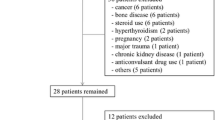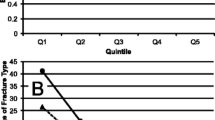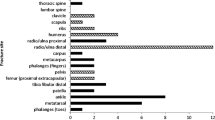Abstract
Hip fractures are common among older women. At the present time, major efforts are being made to identify women with low bone mineral density (BMD). However, more than half of hip fractures occur in women who would not classically be considered osteoporotic by BMD. This study aimed to identify factors associated with hip fracture in women with high BMDs. A total of 7598 French women aged over 74 participated in the EPIDOS study and had BMD measured by dual energy X-ray absorptiometry. Analysis was carried out comparing women with and without hip fractures over more than 3 years of follow-up. The participants were divided into three groups based on femoral neck BMD, so as to have equal numbers in each group (cut-off points=0.601 g/cm2, and 0.683 g/cm2). Multiple risk factors thought to be associated with hip fracture were tested in the high and low BMD groups to search for those whose effect was stronger in the high BMD group. Age adjusted Cox regression was used. Results for continuous variables are reported per standard deviation change. Positive interaction between higher BMD, hip fracture and the following factors were found: age (P<0.01), ultrasound attenuation (P<0.05), urinary deoxypyridinoline (DPD) (P<0.05), left quadriceps strength (P<0.05) and right and left foot coordination (P<0.05). The following factors had a larger hazards ratio in those in the upper third of BMD than the low and were statistically significant: femoral neck BMD, nulliparity, age, ultrasound attenuation and speed, prior fracture, urinary deoxypyridinoline, left grip strength and foot coordination. Multiple factors appear to be more strongly associated with hip fractures in women with high BMD than low. They appear to cluster as factors that may relate to bone turnover and architecture and others which are more subtle measures of left-sided coordination.
Similar content being viewed by others
References
Kanis JA, Johnell O, De Laet C, Jonsson B, Oden A, Ogelsby AK (2002) International variations in hip fracture probabilities: implications for risk assessment. J Bone Miner Res 17:1237–1244
World Health Organization (1994) Assessment of fracture risk and its application to screening for postmenopausal osteoporosis. WHO Technical Report Series 843, World Health Organization, Geneva
Siris ES, Miller PD, Barrett-Connor E, Faulkner KG, Wehren LE, Abbott TA, Berger ML, Santora AC, Sherwood LM (2001) Identification and fracture outcomes of undiagnosed low bone mineral density in postmenopausal women: results from the National Osteoporosis Risk Assessment. JAMA 286:2815–2822
Kanis JA, Melton LJ 3rd, Christiansen C, Johnston CC, Khaltaev N (1994) The diagnosis of osteoporosis. J Bone Miner Res 9:1137–1141
Lips P (1997) Epidemiology and predictors of fractures associated with osteoporosis. Am J Med 103:3S–8S
Black DM, Steinbuch M, Palermo L, Dargent-Molina P, Lindsay R, Hoseyni MS, Johnell O (2001) An assessment tool for predicting fracture risk in postmenopausal women. Osteoporos Int 12:519–528
Schott AM, Cormier C, Hans D, Favier F, Hausherr E, Dargent-Molina P, Delmas PD, Ribot C, Sebert JL, Breart G, Meunier PJ (1998) How hip and whole-body bone mineral density predict hip fracture in elderly women: the EPIDOS prospective study. Osteoporos Int 8:247–254
Guralnik JM, Simonsick EM, Ferrucci L et al. (1994) A short physical performance battery assessing lower extremity function: association with self-reported disability and prediction of mortality and nursing home admission. J Gerontol 49:M85–94
Garnero P, Hausherr E, Chapuy MC, Marcelli C, Grandjean H, Muller C, Cormier C, Breart G, Meunier PJ, Delmas PD (1996) Markers of bone resorption predict hip fracture in elderly women: the EPIDOS prospective study. J Bone Miner Res 11:1531–1538
Wolinsky FD, Fitzgerald JF (1994) The risk of hip fracture among noninstitutionalized older adults. J Gerontol 49:S165–175
Ray WA, Griffin MR, Schaffner W, Baugh DK, Melton LJ 3rd (1987) Psychotropic drug use and the risk of hip fracture. N Engl J Med 316:363–369
Marshall D, Johnell O, Wedel H (1996) Meta-analysis of how well measures of bone mineral density predict occurrence of osteoporotic fractures. BMJ 312:1254–1259
Hillier TA, Joanne H Rizzo JH, Pedula KL, Stone KL, Cauley JA, Bauer DC, Cummings SR (2003) Nulliparity and fracture risk in older women: the study of osteoporotic fractures. J Bone Miner Res 18:893–899
Dargent-Molina P, Favier F, Grandjean H, Baudoin C, Schott AM, Hausherr E, Meunier PJ, Bréart G for EPIDOS Group (1996) Fall-related factors and risk of hip fracture: the EPIDOS prospective study. Lancet 348:145–149
Eastell R (1998) Treatment of postmenopausal osteoporosis. N Engl J Med 338:736–746
Cauley JA, Robbins J, Chen Z, Cummings SR, Jackson RD, LaCroix AZ, LeBoff M, Lewis CE, McGowan J, Neuner J, Pettinger M, Stefanick ML, Wactawski-Wende J, Watts NB (2003) Women’s Health Initiative Investigators. Effects of estrogen plus progestin on risk of fracture and bone mineral density: the Women’s Health Initiative randomized trial. JAMA 290:1729–1738
Eastell R, Barton I, Hannon RA, Chines A, Garnero P, Delmas PD (2003) Relationship of early changes in bone resorption to the reduction in fractures risk with risedronate. J Bone Miner Res 18:1051–1056
Hans D, Hartl F, Krieg MA (2003) Device-specific weighted T-score for two quantitative ultrasounds: operational propositions for the management of osteoporosis for 65 years and older women in Switzerland, Osteoporos Int 14:251–258
Garnero P, Dargent-Molina P, Hans D et al. (1998) Do markers of bone resorption add to bone mineral density and ultrasonographic heel measurement for the prediction of hip fracture in elderly women? The Epidos prospective study. Osteoporos Int 8:563–569
Mazess RB, Barden H (1999) Bone density of the spine and femur in adult white females. Calcif Tissue Int 65:91–99
Author information
Authors and Affiliations
Corresponding author
Rights and permissions
About this article
Cite this article
Robbins, J.A., Schott, A.M., Garnero, P. et al. Risk factors for hip fracture in women with high BMD: EPIDOS study. Osteoporos Int 16, 149–154 (2005). https://doi.org/10.1007/s00198-004-1661-y
Received:
Accepted:
Published:
Issue Date:
DOI: https://doi.org/10.1007/s00198-004-1661-y




